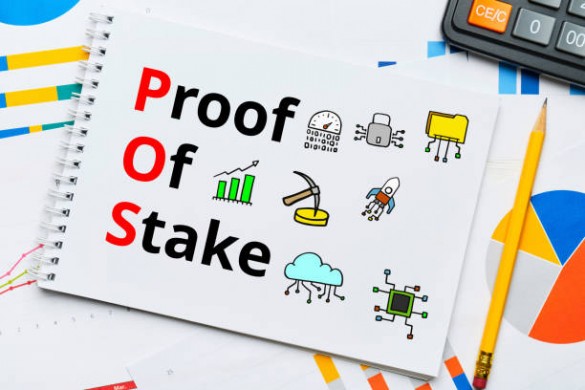Staking your cryptocurrencies may appear difficult, but there are straightforward ways to go about staking your proof-of-stake coins so as to generate interest in your holdings. Centralized exchange platforms can help simplify staking for beginners. However, delegation requires a little more expertise.

The simplest way for beginners to stake crypto is through the services of crypto exchange platforms. By following these simple steps, you will be ready to put your crypto assets up for staking.
• Firstly, join an online staking or exchange platform.
• Compare various staking rates, which include APY, lock-up, minimum stake, and more.
• Purchase the necessary quantity of cryptocurrency.
• Provide the amount that you wish to put up for staking.
The Concept of Crypto Staking
Through the process of crypto, an investor can generate earnings (in the form of interest) while still retaining ownership over their initial investment. It is like earning interest on a deposit in a traditional banking system. The crypto assets are deposited into a specialized staking-compatible digital wallet for a predetermined amount of time.
The platform makes use of the locked crypto during this time to validate transactions and keep the blockchain secure. Then, for this, the owners of the staked coins receive more cryptocurrency as payment. This payment is also known as a “staking reward.” That means investors can earn income on their crypto holdings without trading or mining. The staking process is a more environmentally friendly way of minting new tokens. The other way of making new tokens, which is through mining, is energy intensive, as it requires a large amount of processing power to carry out the process of creating new tokens. However, staking also has certain risks attached. Investors can lose part of their staked assets if the platform faces difficulty.
Only blockchains using the proof-of-stake (PoS) consensus algorithm allow for staking. This makes it possible for network users to agree on which transactions should be verified and added to fresh blocks. The other method, called proof of work, requires participants on the network to race to complete complex puzzles, and the first to solve the puzzle earns a new block. For PoW, a specialized and powerful processing device, which consumes a lot of electricity, is required.
Crypto Staking: How It Works
Staking is about locking away an amount of cryptocurrency in a particular kind of digital wallet. The blockchain network benefits from this in two ways:
• They use staking to secure the blockchain network.
• They use staking to verify transactions.
Through the services provided by staking, the investors are able to support the particular blockchain network, and they are paid for this. Users must first deposit a particular amount of their cryptocurrency into the network in order to engage in crypto staking. The network then chooses validators from among these users to validate transaction blocks. The more cryptocurrency an individual commits, the more likely it is for the node to be selected as a validator. The amount staked, the duration, and the demand for a coin are factors that make the staking reward vary.
Ways of Staking
There are four ways of staking. The first and simplest method is delegation. This is a common option for smaller crypto investors who do not want to commit the time or money necessary to run a validator. In this case, the crypto holders or investors make their coins available to a validator to control. Because this method requires the entrusting of your crypto assets to a third party, it is, therefore, advisable to pick a trustworthy validator or node with a good track record and a good name on the blockchain network.
The second method of staking is the pooled staking service. This staking method merges many validators into a single pool. The likelihood that a pool will earn a staking payment increases with the volume of tokens owned in that pool. Delegation staking is simpler than pool staking, although pools are still worth looking into.
The third way of staking is through Liquid Staking Services (LSS) or Liquid Staking Derivatives (LSDs). In this method of staking, the investors are allowed access to their assets while they still receive interest on them. The advantage of this method is that it provides flexibility and efficiency for the staked assets. However, this type of staking may be a bit beyond new investors who are considering it as a prospect.
The fourth method entails running a validator yourself. This method is the most advanced and technical. Here, an investor is required to have sophisticated technical knowledge. They also need to run and manage their hardware themselves, which means they are the ones who manage their stake, so they have to keep their node online at all times. The benefit of this method is that investors have access to a higher payout.
Becoming a validator is not easy. For example, on the Ethereum blockchain network, investors need to commit 32 ETH to the task. The investor needs to be equipped with the sophisticated knowledge required. Therefore, this method may not be suitable for beginners.
A Few of the Top Staking Tokens
Tezos (XTZ):
• To become a full validator on this platform, a minimum of 6000 XTZ is required.
Solana (SOL):
• There is no minimum token requirement to be a validator on the Solana network, and both the delegator pools and the validators have lock-ups of five days.
Cardano (ADA):
• This platform has no minimum token requirements and no lock-in period.
Polkadot (DOT)
• This platform requires a minimum of 993 DOT and a lock-up of 28 days.
Where to Stake Your Coins
There are three places to stake your coins. They are:
• Centralized Crypto Exchange platforms, such as Binance and Coinbase.
• Staking platform: These are blockchain networks that focus entirely on staking services.
• Private Wallets.
Learn from market wizards: Books to take your trading to the next level.


 Hot Features
Hot Features














